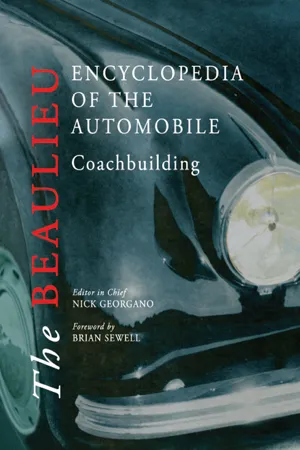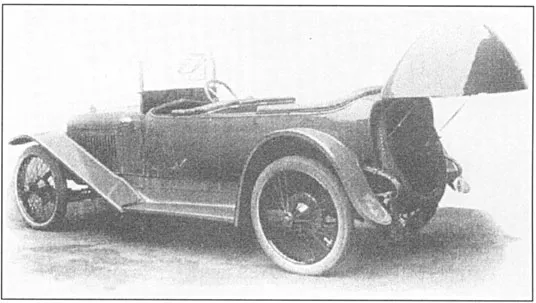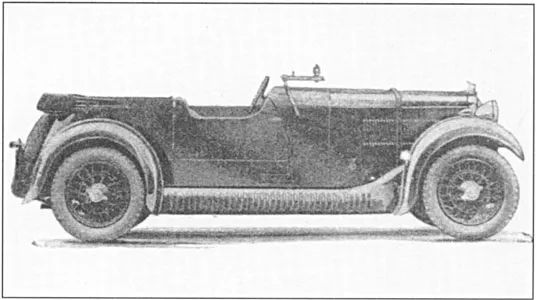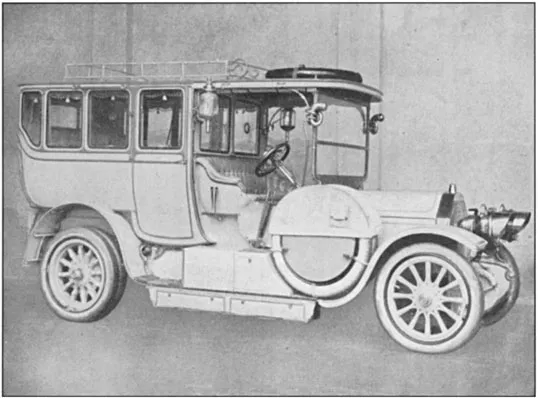
- 424 pages
- English
- ePUB (mobile friendly)
- Available on iOS & Android
eBook - ePub
The Beaulieu Encyclopedia of the Automobile: Coachbuilding
About this book
This volume explores the art of coachbuilding from its roots in the late nineteenth century through to the inevitable decline that set in during the 1950's. This definitive work explores both the great names and the forgotten innovators of the industry with the detailed entries and generous illustrations that have won the Encyclopedia of the Automobile critical raves and legions of fans on both sides of the Atlantic.
Frequently asked questions
Yes, you can cancel anytime from the Subscription tab in your account settings on the Perlego website. Your subscription will stay active until the end of your current billing period. Learn how to cancel your subscription.
At the moment all of our mobile-responsive ePub books are available to download via the app. Most of our PDFs are also available to download and we're working on making the final remaining ones downloadable now. Learn more here.
Perlego offers two plans: Essential and Complete
- Essential is ideal for learners and professionals who enjoy exploring a wide range of subjects. Access the Essential Library with 800,000+ trusted titles and best-sellers across business, personal growth, and the humanities. Includes unlimited reading time and Standard Read Aloud voice.
- Complete: Perfect for advanced learners and researchers needing full, unrestricted access. Unlock 1.4M+ books across hundreds of subjects, including academic and specialized titles. The Complete Plan also includes advanced features like Premium Read Aloud and Research Assistant.
We are an online textbook subscription service, where you can get access to an entire online library for less than the price of a single book per month. With over 1 million books across 1000+ topics, we’ve got you covered! Learn more here.
Look out for the read-aloud symbol on your next book to see if you can listen to it. The read-aloud tool reads text aloud for you, highlighting the text as it is being read. You can pause it, speed it up and slow it down. Learn more here.
Yes! You can use the Perlego app on both iOS or Android devices to read anytime, anywhere — even offline. Perfect for commutes or when you’re on the go.
Please note we cannot support devices running on iOS 13 and Android 7 or earlier. Learn more about using the app.
Please note we cannot support devices running on iOS 13 and Android 7 or earlier. Learn more about using the app.
Yes, you can access The Beaulieu Encyclopedia of the Automobile: Coachbuilding by Nick Georgano in PDF and/or ePUB format, as well as other popular books in Business & Automobile Industry. We have over one million books available in our catalogue for you to explore.
Information
A
ABADAL (E) 1908–1930
Carroceria Francisco Abadal y Cia, Barcelona.
Francisco Abadal was the first sales agent for Hispano-Suiza in Spain. In his workshop he serviced Hispano-Suiza cars, but also created his own coachwork, first only on H-S chassis, later on his own Abadal cars. From 1917 to 1923 he represented Buick, and prepared special bodies for these cars, giving them a more European look with a new, higher radiator for the sedans and open tourer, and a special sharp-pointed one for the sports cars. In 1930 he introduced an American-looking sedan using a lot of Hupmobile components, but his own body.
VCM
ABBEY (GB) 1930–1937
1930–1933 Abbey Coachworks Ltd, Merton, London.
1933–1937 Abbey Coachworks Ltd, Acton, London.
After A.P. Compton had moved to Hanwell, West London in 1930, his erstwhile partner W.H. Terry, together with one D.H.B. Power, remained at the Merton address and formed Abbey Coachworks Ltd. In 1933 the company moved to Minerva Road in the new Chase Estate in Acton, London. The company became well known for its attractive open tourer and drophead designs on mainstream chassis. Some of these were adopted by the manufacturers as catalogued models; others were commissioned and marketed by large dealers. One of the earliest commissions was from Eustace Watkins, the London Wolseley dealer, in 1930, for special bodies – sports 4-seaters and fixed-head coupés – on the Hornet chassis.
Next, Abbey produced a 4-seater sports version of the Rover Speed Twenty and Speed Meteor, and then went on to body MGs for University Motors, Wolseley Hornets for E.C. Stearns, Ford 8s for Dagenham Motors and Morris 10–4s for Jarvis. They also built a sports 2/4-seater on the Vauxhall Light Six, and a 2-door saloon for Railton. However, an unusual series of events then occurred. Abbey had got as far as exhibiting at Olympia for one year (1936), but then found that Martin Walter’s Wingham cabriolet business was up for sale. Abbey not only bought it, but changed its own name to Wingham Martin Walter, and exhibited at Olympia the next year under that name (Daimler and Vauxhall cabriolets and a Delahaye sports saloon). Martin Walter seems to have had the better of the deal, and nothing more was heard of either Abbey or Wingham.
NW
ABBOTT (GB) 1929–1972
E.D. Abbott Ltd, Farnham, Surrey.
In 1929, when the coachbuilding firm Page & Hunt of Farnham in Surrey went into receivership, Edward Dixson Abbott took over the premises and equipment, and formed a new company under his own name. Until then he had been London salesman and specialised coachwork manager; previously, after serving as a naval pilot in World War I, he had been a pupil apprentice at the Wolseley company and had then worked in its design office. It was a brave move at a time when the recession was already beginning to bite. It would appear, however, that Abbott had sensed an opportunity in the commercial body market, and he managed to secure some contracts to construct bus bodies. He also developed the car retailing side of the business. Nevertheless, car bodybuilding continued.
The new company exhibited at Olympia for the first time in 1931, and did so every year thereafter until World War II. As a first move it joined the fashion for putting special bodies on the Austin Seven chassis, producing fixed-head coupés, drophead coupés and saloons. It was no doubt Abbott s previous knowledge of the London scene which helped him to later develop associations with major dealers; he was soon bodying Daimlers and Lanchesters for Stratstone and Talbot 105s for Pass & Joyce. The Talbot connection was to develop into a substantial source of business after the Rootes takeover in 1935, and even into 1938 when the marque had become Sunbeam-Talbot, with Abbott constructing various designs of drophead coupé on the 10hp chassis.
A measure of the size of the Talbot business can be gained from the effect of a major fire at Farnham in late 1935 (from which happily the firm made a quick recovery): no less than 25 Talbot chassis were destroyed, as well as many others. At around this time (1934) the firm obtained the contract from the Lagonda company for coachwork on the new Rapier; Gerry Maddox, formerly of the Maddox company of Huntingdon which had recently ceased trading, is credited with helping to obtain the order. It involved sports, drophead coupé and sports saloon designs, and must have represented the major part of Abbott’s workload during 1934–5. Unfortunately it ended in receivership for Lagonda, and although some Rapier production continued under the new Rapier Cars company, very few were bodied by Abbott. Another useful, although smaller, contract which ran at the same time as the Rapier contract was with Frazer Nash-BMW; around 40 chassis were imported from Germany, and Abbott clothed them with saloon and coupé bodies. Abbott also had an involvement with Aston Martin, starting with the 1½-litre saloon in 1934, and going on to drophead coupé bodies for the 2-litre chassis in 1937–38.

ABADAL tourer on 1911 Hispano-Suiza 15/20hp chassis.
EMILIO POLO

ABADAL tourer on 1920 Buick 15/30hp chassis.
FERANDO LOPEZ-FANJUL

ABBEY sports 4-seater on 1932 Rover Speed chassis.
NATIONAL MOTOR MUSEUM

ABBOTT drophead coupé on 1937 2-litre Aston Martin chassis.
NICK GEORGANO/NATIONAL MOTOR MUSEUM

ABBOTT drophead coupé on 1950 Bentley Mark VI.
NICK GEORGANO

ALESSIO limousine on 1906 Itala 28/40hp chassis for Queen Margherita of Italy.
GRUPPO COSTRUTTORI CARROZZERIE
After World War II, Abbott was among the few to restart bodybuilding activities. Initially it even picked up its Sunbeam-Talbot connection, once more building drophead coupés. There followed drophead bodies on such chassis as Bentleys and Lanchester LDlOs, then the special-bodied Healey Abbott, and even some Bentley saloons. In 1950 Abbott decided to retire, and the company was sold to Gordon Sutherland, owner of Friary Motors and former owner of the Aston Martin company. He continued the Bentley connection but also developed a close relationship with the Bristol company, with some 40 or more 405s bearing drophead coupé bodies by Abbott. Eventually it found a niche in converting the larger Ford saloons into estate cars. This was good business for the company in the 1950s and early ‘60s, but then died away; Abbott later became part of the Giltspur group, and finally closed in 1972.
See colour section, page 49.
NW
A.C.B. (F) 1947–c.1950
Ateliers de Carrosserie de Bécon, Courbevoie, Seine.
Like Antem, Esclassan and others, A.C.B. built their own custom styles on well-known chassis, particularly the Peugeot 202 and Citroen 11CV. Some of the latter, such as the cabriolet shown at the 1948 Paris Salon, were based on lowered prewar frames. In 1982 the name was revived by M. Broual (Ateliers de Carrosserie Broual) for a small series of replicas of prewar sports cars such as Delage D6, Delahaye 135 andTalbot-Lago.
NG
ACHARD & FONTANEL (F) c.1902-c 1926
Achard, Fontanel & Cie, Lyon.
The company was established in approximately 1902 and produced bodies mainly for local car makers (Rochet-Schneider, Berliet, Pilain). In 1924 it purchased the manufacturing rights to Paul Audineau’s ‘clairalpax’ aluminium-panelled construction and Gustave Baehr’s all-weather transformable body types. Series production of bodies for Rochet-Schneider went on until 1926 or beyond. JPN
ALESSIO (I) 1899–1929
1899–1906 Officina Lavorazioni Carrozzerie per Automobili, Turin.
1906–1929 Carrozzeria Alessio, Turin.
Marcello Alessio was born in Piemonte about 1850 and became a master of his trade in the shops of Locati &Torretta in Turin. He first attracted wider attention by exhibiting a mail coach at the Turin Fair in 1898.
The following year he established the Officina Lavorazioni Carrozzerie per Automobili in Turin and made bodies for the Welleyes cars, Michele Lanza, Prinetti & Stucchi, and Fiat. In 1905 Alessio opened branches in Rome and Na...
Table of contents
- Cover
- Half Title
- Title Page
- Copyright Page
- Dedication
- Table of Contents
- Alphabetical List of Colour Illustrations
- Alphabetical List of Original Manufacturers’ Promotional Images
- Foreword
- Acknowledgements
- Introduction
- Terms and Abbreviations Used
- History of Coachbuilding
- Alphabetical List of Makes
- Supplementary List
- Glossary
- Contributors to the Encyclopedia